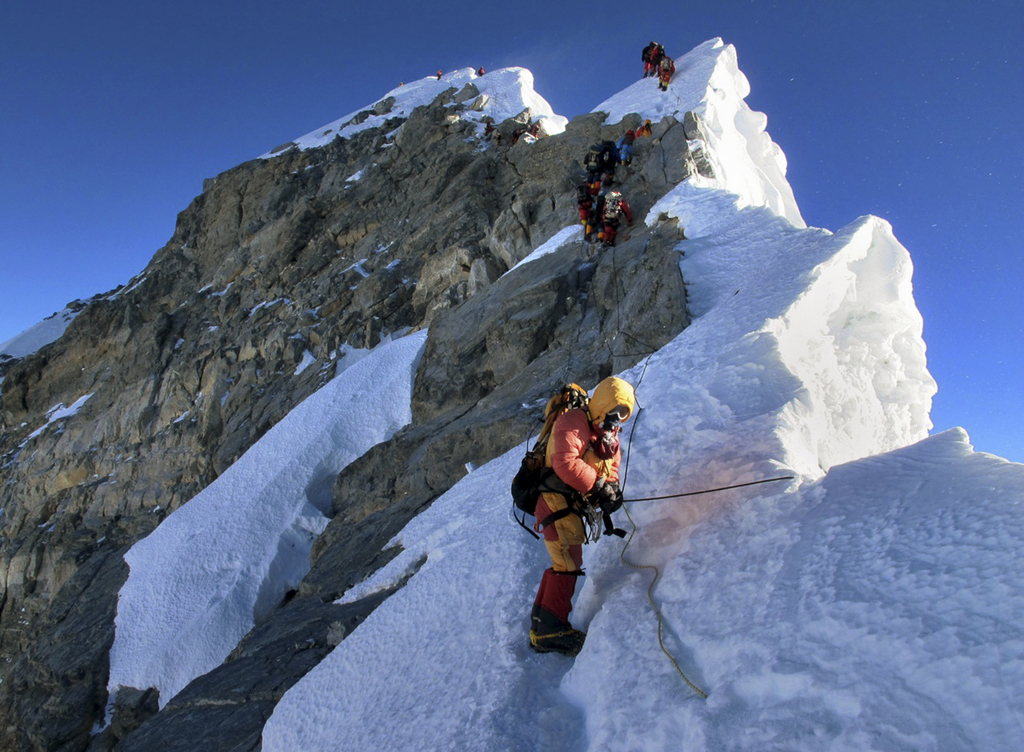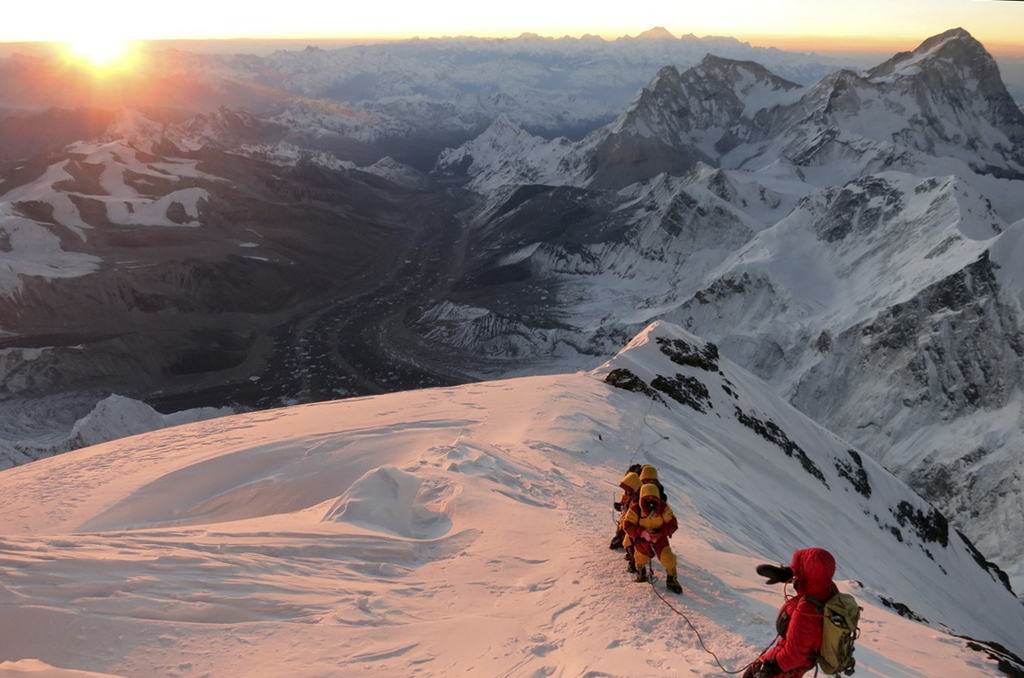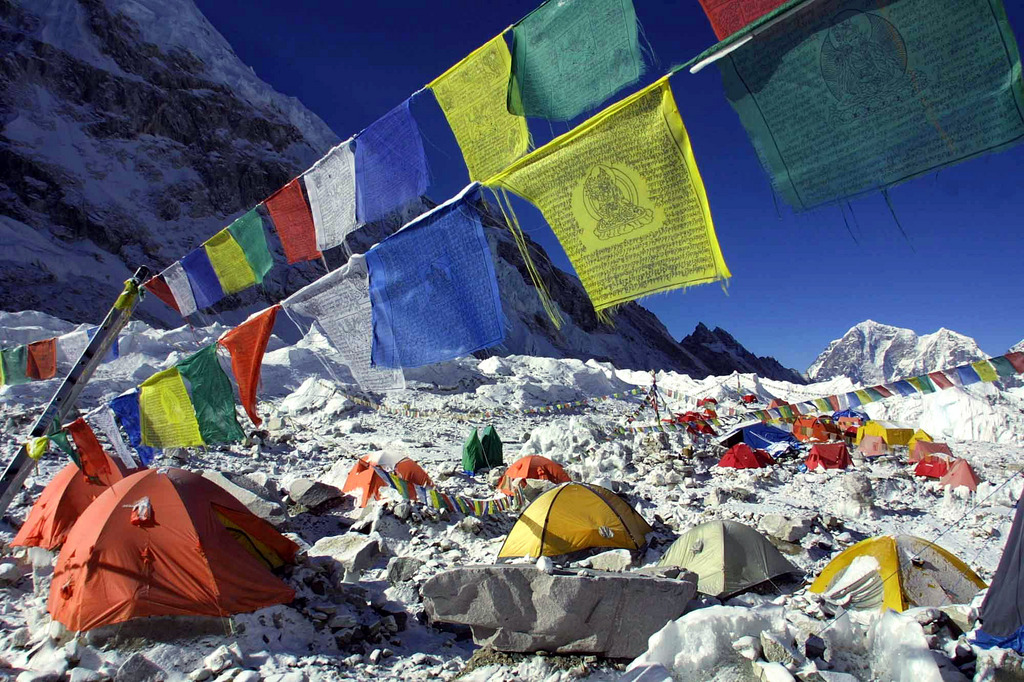Researchers take oxygen tests to new extremes

A Swiss-led team is carrying out one of the biggest ever high-altitude research projects. The 70-odd physicians, researchers and participants hope their oxygen trials in the Himalaya will, among other things, provide clues about cancer cells.
Pedalling on an exercise bike at 7,000 metres as well as taking more than 7,000 blood samples are just a few of the challenges the Swiss-Exped team face on the four-week expedition in October.
“Labelling the blood samples properly, not mixing them up and keeping them at a constant temperature of -20 Celsius isn’t going to be easy up there,” expedition leader Urs Hefti told swissinfo.ch.
This is only one of Hefti’s numerous worries in this medical research project to the 7,126m Himlung Himal in Nepal.
“Anything can go wrong in the hostile conditions of the high Himalaya, but we are well prepared for most eventualities and have put together a competent team,” the 45-year-old orthopaedic surgeon said.
Himlung lies in western Nepal and is 7,126 metres high.
A Japanese team first climbed it in 1992.
The team of 24 researchers and 42 test persons will take seven days to trek to base camp.
Acclimatising to a higher altitude is done slowly and starts at about 3,300m, from where a human should only ascent 300m per day. The entire project is due to last a month.
Brain, heart, lungs and the blood circulation will be tested.
‘Exciting opportunity’
With this expedition, Swiss-Exped is following up its studies on Shisha Pangma in Tibet in 2001, Muztagh Ata in China in 2005 and Pik Lenin in Kyrgyzstan in 2009. The research will focus on the functioning of the lungs and brain at high altitude as well as how low oxygen levels, called “hypoxia”, affect the body.
“The Swiss have a very exciting opportunity to make measurements at 7,000m with a reasonably large group of subjects,” said Mike Grocott, professor of anaesthesia and critical care medicine at the University of Southampton in Britain.
“This study could further help us improve the understanding of how cancer cells react to hypoxia.”
Tumour cells that do not have enough oxygen can be resistant to radiotherapy and chemotherapy, but it is thought that this could change if the amount of oxygen in the cells is increased.
This would be particularly relevant to hospital medicine. Intensive care patients for example often suffer from lack of oxygen (see box).
“It has the potential to benefit both patients where oxygen levels are often an important problem and high-altitude trekkers and mountaineers,” Grocott said.
“New information may allow us to better predict who is likely to thrive and perform best at high altitude, and in particular, to identify individuals who may be particularly susceptible to high altitude illnesses.”

More
The lowdown on altitude sickness
Tough selection criteria
The team of 24 researchers prepared for nearly two years during which they found sponsors, tested the highly sensitive and costly material and recruited 40 participants, nearly half of whom are women.
“I’m very excited to take part in this expedition. It’ll be very interesting to find out more about my body while I climb high,” said Dominik Meyer, who was chosen from a total of 150 suitable applicants.
The selection criteria were tough, and participants had to have a reasonable degree of mountaineering experience with a good medical history.
“People who suffer from a certain illness, take steroids or used to smoke did not qualify,” Hefti explained. “The lung is an essential part of our research and has to be absolutely clean.”
However, not only the researchers have worked around the clock over the past 12 months; the subjects, who will have to undergo regular tests on the mountain as well as take on the difficult task to climb such a high peak, have also been doing their bit.
“I trained hard for six months. Twice a week, I carried a rucksack full of rocks weighing 25kg up my local mountain,” Meyer explained. “I know that I am physically well prepared, but I have no idea what to expect mentally on this big expedition.”
Buddha Basnyat, a high altitude expert from Nepal, talks research into high altitudes.
swissinfo.ch: There are a lot of researchers coming to Nepal. Do you think there is still scope for the Swiss-Exped expedition?
Buddha Basnyat: High altitude research deals with ‘hypoxia’, which means low oxygen and is very relevant to hospital medicine. Intensive care patients often suffer from lack of oxygen and so do fit and healthy people at high altitude. We still need to find out whether there are any pointers to how we can apply high altitude medicine to a patient, who may have chronic lung disease.
swissinfo.ch: Despite all the research that has been done, are we still at the beginning?
B.B.: It is all very laborious and connecting the dots will take many years. One single research team is unlikely to come up with anything revolutionary. It takes a consortium of scientists, like the British, the Americans, the Swiss and so on. High altitude research is like climbing Mount Everest, which took a long time.
High altitude research goes as far back as the Middle Ages. Father Acosta, a Spanish Jesuit missionary, went to Peru in the 16th century and found out that the thin air in the Andes caused his headache. Being a Jesuit, he documented his findings and they are now kept in the Vatican.
Later in the 1960s, when scientific tools still lacked in sophistication, researchers came to Nepal and did a lot of revolutionary studies, such as the Silver Hut expedition in the Everest region in 1961. This British-led research team was the first to document that maximal oxygen consumption, so-called ‘VO2 max’, is reduced with altitude. These guys did sophisticated research demanding immense passion and commitment as well as the preparedness to be exposed to the elements for a long time.
swissinfo.ch: It sounds as if there is still a lot to be done.
B.B.: Oh, yes. We still do not know whether AMS [acute mountain sickness] is actually genetic. Some people are more predisposed than others, which could be due to the genes but we don’t know what these genes are. We know about cerebral oedema, but we do not really know where it takes place and what exactly happens.
Complicated
The challenges of this expedition are manifold and do not only concern research. “I think the logistics for this trip are more difficult than organising an Everest expedition,” said expedition operator Kari Kobler, who has organised trips to the highest mountain in the world for more than 25 years.
“We sent six trucks with 1.3 tonnes of material to the start of the trek from where porters and mules carried it to base camp at 4,900m.”
The material includes an ergometer, ultrasound machines, laptops and thousands of fragile test tubes.
“Our team has spent a lot of time, effort and money on packing the technical equipment well enough to survive the bumpy journey to base camp and the treacherous climbs to the higher camps,” said Hefti.
All these technical gizmos need a lot of power, which seems to be a bit of a headache for Kobler. “At base camp we will try to use solar power. However, the Sherpas will have to take generators weighing around 8kg to the higher camps to power the ultrasound machines up there.”
Oxygen for researchers
The highest tests will be carried out at an altitude of 7,000m, which Hefti thinks is unprecedented given the large number of people that will undergo the tests up there.
“There have been cases when two or three subjects were tested higher up, but you need more people to get valuable results,” he explained.
As the researchers are due to spend two nights at that altitude, where the amount of oxygen in the air is only eight per cent (compared with 21 per cent at sea level), they will sleep on bottled oxygen. “We have never used oxygen before, but we have learnt from past experience that it is essential for us to think clearly up there.”
Eight mountain guides and a total of 35 climbing Sherpas, who are indispensable on most commercial Himalayan expeditions, will support the team. “Without the Sherpas such a trip would simply not be possible,” Kobler observed. “They pitch the tents, they carry, they fix the ropes and they look after the participants.”
Luxuries
During their long rest and acclimatisation phases, the team will be dining in heated mess tents, which together with the other 70-odd tents, had to be pitched on very flat ground. “The Sherpas worked for four days to make platforms. I felt dizzy just watching them,” said Kobler, who had gone ahead to set up base camp.
As far as the outcome is concerned, however, Hefti does not expect any big breakthroughs in the short-term. Once back in Switzerland, they will do further tests on the participants before evaluating findings, which will take another nine months to one year.
Grocott, who led the British Xtreme Everest research expedition to Mount Everest in 2007, had a similar experience. “We haven’t really changed practice or saved lives with our data, but we have finally started experiments on patients which are directly related to what we found out in 2007.”
Whether or not the Swiss-Exped expedition will come up with anything revolutionary remains to be seen. But Hefti and his team are convinced that every little bit can help intensive care patients.
“There are a lot more sick people than high altitude mountaineers, and if we can find something that helps these sick people, even on a small scale, our mission is accomplished.”

In compliance with the JTI standards
More: SWI swissinfo.ch certified by the Journalism Trust Initiative

You can find an overview of ongoing debates with our journalists here. Please join us!
If you want to start a conversation about a topic raised in this article or want to report factual errors, email us at english@swissinfo.ch.